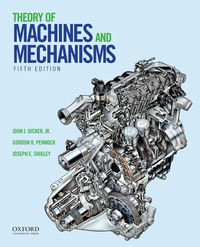Shaper gear cutters have the advantage that they can be used for either external or internal gears
Question:
Shaper gear cutters have the advantage that they can be used for either external or internal gears and also that only a small amount of runout is necessary at the end of the stroke. The generating action of a pinion shaper cutter can easily be simulated by employing a sheet of clear plastic.
Figure P 7.20 shows 1 tooth of a 16-tooth pinion cutter with 20◦ pressure angle as it can be cut from a plastic sheet. To construct the cutter, lay out the tooth on a sheet of drawing paper. Be sure to include the clearance at the top of the tooth.
Draw radial lines through the pitch circle spaced at distances equal to one fourth of the tooth thickness, as shown in the figure. Next, fasten the sheet of plastic to the drawing and scribe the cutout, the pitch circle, and the radial lines onto the sheet.
Then, remove the sheet and trim the tooth outline with a razor blade. Next, use a small piece of fine sandpaper to remove any burrs.
To generate a gear with the cutter, only the pitch circle and the addendum circle need be drawn.
Divide the pitch circle into spaces equal to those used on the template and construct radial lines through them. The tooth outlines are then obtained by rolling the template pitch circle upon that of the gear and drawing the cutter tooth lightly for each position. The resulting generated tooth upon the gear will be evident. The following problems all employ a standard 1-tooth/in diametral pitch 20◦ full-depth template constructed as described earlier. In each, case, you should generate a few teeth and estimate the amount of undercutting.
Table P7.20 to P7.24 Problem no. P7.20 P7.21 P7.22 P7.23 P7.24 No. of teeth 10 12 14 20 36
Step by Step Answer:

Theory Of Machines And Mechanisms
ISBN: 9780190264482,9780190264536
5th Edition
Authors: John J. Uicker Jr, Gordon R. Pennock, Joseph E. Shigley




